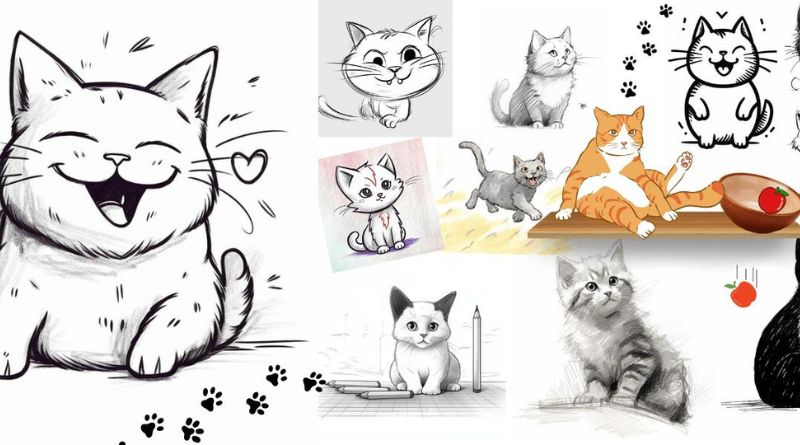Cats have captivated the hearts of people for centuries, inspiring countless artists to depict their charm through various forms of art. Drawing a cat can be a rewarding and enjoyable experience, whether you’re a beginner looking to enhance your artistic skills or an experienced artist seeking to refine your technique. This article will provide a comprehensive guide on drawing cats, covering essential tips, techniques, and common questions.
Table of Contents
Why Draw Cats?
- Expressive and Diverse: Cats come in various breeds, colors, and personalities, making them a rich subject for artistic expression. Each cat has unique features and quirks, allowing artists to capture their individuality.
- Relaxation and Enjoyment: Drawing can be a form of relaxation and a great way to relieve stress. Engaging in creative activities, like drawing cats, can be therapeutic and enjoyable.
- Skill Development: Drawing animals helps improve your observation skills and understanding of anatomy. Cats have distinctive shapes and proportions that can challenge and enhance your drawing abilities.
Essential Tips for Drawing Cats
1. Observe Your Subject
Before you start drawing, spend some time observing a cat. Notice the shape of their body, the position of their legs, the curve of their tails, and the details of their fur. You can sketch from a live cat or use reference photos for guidance.
2. Basic Shapes
Start by breaking down the cat’s body into basic shapes. For example:
- Head: Use a circle or oval to form the head.
- Body: An elongated oval can represent the torso.
- Legs: Use straight or slightly curved lines for the legs, depending on the position of the cat.
- Tail: Draw the tail with a long, flowing line.
3. Adding Details
Once you have the basic shapes, refine your drawing by adding details:
- Facial Features: Pay attention to the eyes, nose, and mouth. Cats have expressive eyes, and capturing their shape and emotion is crucial.
- Ears: Cats have triangular ears, which can vary in size depending on the breed.
- Fur Texture: Use short strokes to create the illusion of fur. Pay attention to the direction of the fur growth to make it look more realistic.
4. Shading and Highlights
To add depth and dimension to your drawing, incorporate shading and highlights:
- Light Source: Determine where the light is coming from and add shadows accordingly. Use darker shades where the light doesn’t hit and lighter tones where it does.
- Blending: Use a blending tool or your fingers to smooth out the shading for a more natural look.
5. Practice, Practice, Practice
Like any skill, drawing takes practice. Don’t be discouraged if your first attempts don’t meet your expectations. Keep experimenting with different poses, expressions, and styles.
Drawing Styles to Explore
- Realistic Drawing: Focus on capturing the details and textures of the cat as accurately as possible.
- Cartoon Style: Use exaggerated features and playful expressions to create a fun representation of a cat.
- Abstract Art: Use shapes, colors, and forms to convey the essence of a cat without adhering to realistic portrayals.
FAQs
1. What materials do I need to draw a cat?
You can start with basic materials like pencils, erasers, sketch paper, and colored pencils or markers if you wish to add color. More advanced artists may prefer charcoal, pastels, or digital tools.
2. Do I need to have drawing experience to draw a cat?
No, you don’t need prior experience. Drawing is a skill that improves with practice, and anyone can learn to draw cats with patience and dedication.
3. How long does it take to draw a cat?
The time it takes to draw a cat can vary based on your skill level and the level of detail you want to achieve. A simple sketch might take 15–30 minutes, while a detailed drawing could take several hours.
4. Can I draw a cat from a photo?
Absolutely! Using reference photos is a common practice among artists. It can help you capture accurate proportions and details.
5. What are some common mistakes to avoid when drawing cats?
Some common mistakes include neglecting the cat’s anatomy, drawing stiff poses, and overlooking the importance of fur texture. Always refer to real-life examples or photos for better accuracy.
6. Are there online resources for learning to draw cats?
Yes, many online tutorials, videos, and courses can help you improve your cat drawing skills. Websites like YouTube and art blogs often provide step-by-step guides.
Conclusion
Drawing cats is a fulfilling and enjoyable endeavor that allows you to express your creativity while honing your artistic skills. By observing their unique features, breaking down their shapes, and practicing regularly, you can create beautiful representations of these beloved animals. Whether you aim for realism or a more whimsical style, the key is to enjoy the process and keep experimenting with your art. So grab your sketchbook, find a cozy spot, and let your creativity flow as you draw these fascinating feline companions!
